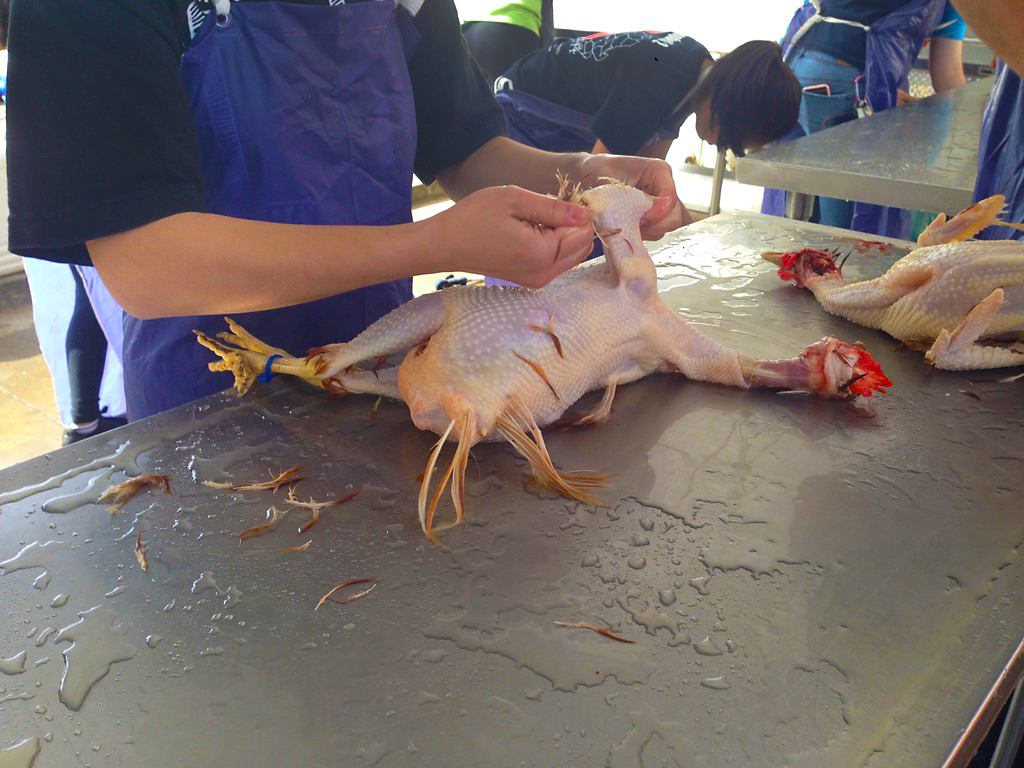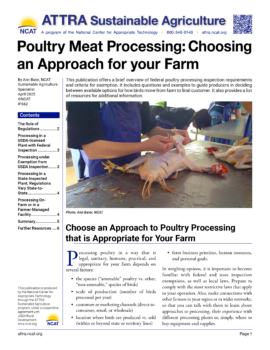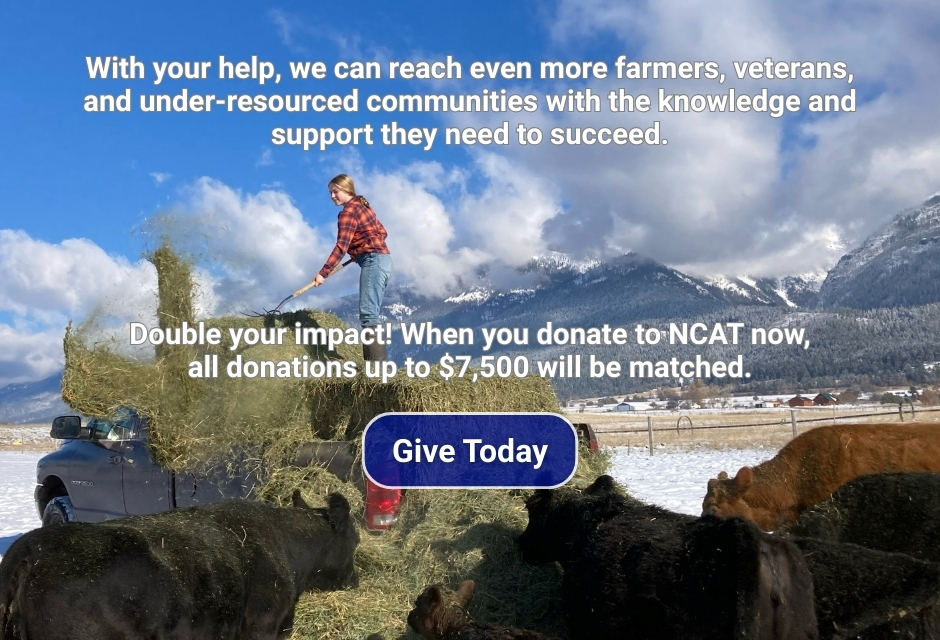Poultry Meat Processing: Choosing an Approach for your Farm
By Ann Baier, NCAT Agriculture Specialist
Abstract
This publication offers a brief overview of federal poultry processing inspection requirements and criteria for exemption. It includes questions and examples to guide producers in deciding between available options for how birds move from farm to final customer. It also provides a list of resources for additional information.
Contents
The Role of Regulations
Processing in a USDA-licensed Plant with Federal Inspection
Processing Under Exemption from USDA Inspection
Processing in a State-Inspected Plant; Regulations Vary State-to-State
Processing On-Farm or in a Farmer-Managed Facility
Summary
Further Resources
Choose an Approach to Poultry Processing that is Appropriate for Your Farm
Processing poultry in a way that is legal, sanitary, humane, practical, and appropriate for your farm depends on several factors:
- the species (“amenable” poultry vs. other, “non-amenable,” species of birds)
- scale of production (number of birds processed per year)
- customers or marketing channels (direct-to-consumer, retail, or wholesale)
- location where birds are produced vs. sold (within or beyond state or territory lines)
- farm business priorities, human resources, and personal goals.
In weighing options, it is important to become familiar with federal and state inspection exemptions, as well as local laws. Prepare to comply with the most restrictive laws that apply to your operation. Also, make connections with other farmers in your region or in wider networks, so that you can talk with them to learn about approaches to processing, their experience with different processing plants or, simply, where to buy equipment and supplies.
Here are some example poultry-processing scenarios:
- A producer raises small batches of broiler chickens to assess how a poultry enterprise may fit with their whole-farm workflow and marketing plan. They invest in equipment (kill cones, scalder, plucker, ice bath, stainless steel table, and knives) to set up an on-farm processing facility to process birds for direct sale to consumers. As they grow the business, they can meet the criteria for federal inspection exemption (Producer Grower or Other Person <20,000 birds per year limit). However, their state’s stricter regulations (see specifics in the section below) limit slaughter to 1,000 birds per year (unless they use only family labor or sell all their production directly from the farm). Although the farm crew is skilled, the stamina required for the work is significant, and long processing days take a toll on their quality of life.
- A farmer raises a few thousand broilers per year for direct local markets. The processing is humane, efficient, and sanitary. Recordkeeping fulfills criteria for exemption from federal and state inspection. To grow their business to support full-time on-farm employment, however, they need to produce more than 20,000 birds per year and also sell to stores. So, they invest in poultry transport crates and a reliable vehicle to carry the birds a 2.5-hour drive to the nearest USDA-inspected plant that does fee-for-service processing for independent producers. They pick up production in a refrigerated truck, delivering fresh product to their customers that can now include restaurants, stores, and distributors. They also need cold storage capacity to even out the supply and demand.
- Another farmer added a quail meat enterprise to their diversified vegetable operation. Quail, as non-amenable species, could be processed in a state-licensed plant. However, the nearest such plant is several hours away and has a processing minimum of 250 birds per batch, which is beyond the scale of their marketing and storage capacity on their farm. They instead set up on-farm processing, meeting criteria for exemption from state inspection requirements.
- A mid-sized operation wants to sell duck meat to a specialty market. They develop a schedule to produce and process the birds at a state-licensed processing plant. They coordinate production with the duckling hatchery, capacity of their land and labor, the minimum number of birds that the plant will process, and the volume of birds their main customer has committed to buy. If orders vary or are skipped, any extra state-inspected birds may be sold through a local distributor, but only within the state, not across state lines. That works, because they live in the middle of a large state.
This publication offers a brief overview of federal inspection requirements and criteria for exemption, and it poses questions to guide your decision-making process about how birds move from farm to final customer. Resources include links to government agencies and regulations, Cooperative Extension, and nonprofit organizations that provide regulatory and technical information, research/case studies, and opportunities for peer learning, mentorship, and grants.
The Role of Regulations
or poultry meat to be used for human consumption, federal regulations state that birds must be: healthy when slaughtered; processed under sanitary conditions, wholesome, not adulterated, and accurately represented to the customer with proper marking, labeling, and packaging. These essential provisions of the Poultry Products Inspection Act (PPIA) apply no matter where birds are processed. Poultry may:
- be inspected in a USDA plant with federal inspection; or
- qualify for an exemption from federal, USDA inspection.
If exempt, processing may take place:
- in a state-licensed facility; or
- by the producer, on-farm or in their own facility, when criteria for exemption from both USDA inspection and state inspection are met.
Whether an operation is inspected or exempt from federal inspection, it must comply with all other applicable federal, state, and local regulations for poultry production, processing, and sales, including, but not limited to, these: zoning, permits, licenses, labeling, environmental health, retail food laws, employee health and safety, water supply, waste disposal, and wastewater management. All poultry labeling must include the name and address of the processor (responsibility statement), and safe handling instructions.
Amenable vs. Non-Amenable Species
“Poultry,” per the USDA definition of “amenable species,” includes “any domesticated bird: chickens, turkeys, ducks, geese, guineas, ratites [ostrich, emu and rhea], or squabs, also termed young pigeons one to thirty days of age.” Other species, such as pheasant, quail, or other waterfowl, are considered “non-amenable” and therefore are not “poultry.” Why does this distinction matter? Federal inspection of poultry is mandatory, and the cost of that inspection service, when done in federally inspected plants, is covered by USDA’s Food Safety Inspection Service (FSIS). Non-amenable species may be inspected in a USDA plant, but the producer pays inspection costs because their federal inspection is voluntary. Non-amenable species are typically processed in state-licensed plants.
Processing in a USDA-licensed Plant with Federal Inspection
When poultry is processed at a federally inspected plant, an unlimited number of birds may be sold to any type of customer, either within the state or across state lines. Such facilities operate with continuous daily bird-by-bird inspection by the United States Department of Agriculture’s Food Safety Inspection Service (USDA-FSIS), mandated by the Poultry Products Inspection Act (PPIA). Facilities may receive live birds, process (slaughter, eviscerate, and cool) them, and, if they qualify, package and label them as “USDA inspected and passed.” The USDA’s Food Safety Inspection Service maintains a Meat, Poultry and Egg Product Inspection Directory. You can search this directory by state and activity (e.g., slaughter) to find a plant in your region, then inquire whether they will process birds on a fee-for-service basis.
Considerations and Questions for Processing in a Plant
- Where is the nearest USDA poultry plant that does fee-for-service processing?
- What is the minimum batch size and/or frequency of batches the plant will process?
- What are the costs per bird? Are there other costs? Does the plant package and label?
- Who will your contact be at the plant? Who on your farm will coordinate and communicate?
- What days will you process? What time will you need to arrive? What is the driving time and distance from your farm to the processing plant? Who will drive?
- Do you have a well-maintained vehicle that will hold the necessary number of crates of birds?
What procedures ensure the vehicle is in good working order, with adequate fuel to reliably deliver birds to the plant?- Have you developed an enterprise budget to include up-front costs, including crates?
What time will you need to pick up the product?- How will you carry the product from the plant to the customer? Coolers? Refrigerated truck?
- Where will you store processed product?
Processing under Exemption from USDA Inspection
The Poultry Products Inspection Act (PPIA) requires USDA inspection of poultry meat yet provides criteria for exemptions. An amendment to the PPIA, Public Law 90-492, describes the conditions for poultry processing and sale of products under exemption from federal inspection. Each exemption specifies criteria including limitations on the number of birds that can be sold and to what type of customer (direct to consumers or otherwise). Processing exempt from federal inspection may be done on-farm, in a farmer-managed facility, or in a state-licensed facility (see clarification below). Exempt poultry may be sold only within the state, territory, or District of Columbia where it was produced, not across state lines. Shipping containers must bear the producer’s name and address and the statement Exempt P.L. 90-492” (required for production over 1,000 birds per year and recommended for less than 1,000 birds per year).
Exemptions are described in “Guidance for Determining Whether a Poultry Slaughter or Processing Operation is Exempt from Inspection Requirements of the Poultry Products Inspection Act.” Producers may slaughter and sell poultry meat they raise under the Producer/Grower; and Producer and Grower or Other Person (PGOP) inspection exemptions. The Small Enterprise exemption allows slaughter and dressing (cutting up) of poultry that is either raised or purchased. The Retail exemption applies to poultry that have already passed USDA or state inspection, allowing them to be cut up, boned, stuffed, smoked or rendered, marinated, and packaged for direct sale (not for resale) with specified limitations. The producer described in Scenario B, above, operates under the retail exemption when selling household-sized packages of marinated chicken breasts and thighs at the local farmers market.
Processing in a State-Inspected Plant: Regulations Vary State-to-State
State poultry-processing regulations vary. If your state (see States With and Without Inspection Programs) does not operate a Meat and Poultry Inspection program considered at least equivalent to USDA inspection, then processing done in a state-inspected facility needs to qualify for one of the federal inspection exemptions. Ask your Cooperative Extension or consult the Niche Meat Processor Assistance Network (NMPAN) poultry-specific resources to learn more about laws in your state.
Processing On-Farm or in a Farmer-Managed Facility
You can process poultry yourself, without a USDA or state-licensed inspector when you qualify for both federal and state inspection exemptions.
Considerations and Questions for Processing On-Farm
- Have you developed an enterprise budget to include up-front costs?
- Have you set up a facility with the necessary equipment to process in an efficient and sanitary manner, including kill cones, sharp knives, scalder, plucker, chill tank, stainless steel tables, buckets for offal, calibrated scale, etc.?
- Do you have qualified skilled labor, trained in the procedures for processing and recordkeeping?
Have you prepared, and had approved, a label to represent your product truthfully to your customers?- How will you transport the product to the customer after processing? Coolers? Refrigerated truck?
- Where will you store product until it is sold?
- How does this enterprise and processing approach fit in with, and contribute to, your whole-farm goals?
Table 1: Considerations for Choosing an Approach to Processing Poultry Meat for Sale
| Processing Approach | Inspection | Marketing / Customer Type | Limitations, Advantages and Disadvantages | Labeling |
|---|---|---|---|---|
| Federal USDA Inspection | Continuous bird-by-bird inspection by a federal inspector | Any type of customer. Intrastate sales or interstate commerce | Unlimited number of amenable species.*
Finding a plant can be challenging; few plants offer fee-for-service processing to independent producers. | “USDA inspected and passed” |
| Exempt from USDA Inspection:
a. State-inspected b. On-farm; Exempt from both federal and state inspection. | Exemption is from USDA inspection requirements only.
Meet other provisions of the PPIA and state and local regulations | Number and customer limitations depend on the exemption.
Interstate commerce allowed only through Cooperative Interstate Shipping (CIS) Agreements Process | Meet criteria for federal inspection exemption; operate under one exemption per year.
Poultry or non-amenable species; slaughter up to 20,000 birds/year under Producer/Grower; PGOP, or Small Enterprise exemptions. Retail exemption allows further processing of USDA-inspected birds. Limits on the number of birds vary according to state regulations, some of which are more restrictive. Comply with state and local regulations. | Exempt
P.L. 90-492 Regarding inspection markings for poultry processed in state-licensed facilities, refer to |
*Non-amenable species may be inspected in a USDA plant, but because their federal inspection is not mandatory, the producer pays inspection costs, rather than USDA/FSIS.
Summary
Processing poultry in a USDA plant provides the greatest flexibility in marketing. This approach is necessary if you raise and slaughter more than 20,000 birds per year, sell meat across state lines, or sell to buyers who re-sell meat. This is possible if there is a USDA processing plant that does fee-for-service processing within a reasonable driving distance. Processing in a USDA plant may also be appropriate if you are not set up, or simply do not want, to do your own processing. Processing birds under exemption from USDA inspection may be an appropriate approach if you are located at too great a distance from a USDA plant, or if you raise non-amenable species. You may process birds in a state-inspected plant if your volume of sales is less than 20,000 birds per year; if you sell to customers located within state lines (unless there is a cooperative shipping agreement), and if there is a state-licensed plant that is accessible to your farm. Processing on-farm or in your own facility, under dual (federal and state) inspection exemption may be an appropriate approach if you have the capacity for sanitary slaughter and processing and can package and label your product to represent it truthfully to your customers.
Further Resources
United States Department of Agriculture (USDA) Food Safety Inspection Service (FSIS)
www.fsis.usda.gov
Meat and Poultry Inspection Plant Directory
Inspection of Poultry Products
Poultry Products Inspection Regulations, Poultry Products Inspection Act (PPIA)
Small and Very Small Plant Guidance (Small Plant Help Desk and Grants & Financial Options)
Guidance for Determining Whether a Poultry Slaughter or Processing Plant is Exempt from Inspection Requirements of the Poultry Products Inspection Act
U.S. Food and Drug Administration
HACCP Principles & Application Guidelines
American Pastured Poultry Producers Association (APPPA)
A nonprofit trade organization for the pastured poultry industry.
Poultry Processing Regulations
Niche Meat Processors Association Network (NMPAN) nichemeatprocessing.org
A national extension project and processors network.
Join the Listserve (active information exchange)
Poultry Specific Resources
Meat Processing Feasibility Studies
Testing The Idea: Using Existing Research to Assess Meat Processing Options
Poultry Processing Regulations and Exemptions
A Best-Practices Guide to Open-Air Poultry Slaughter
Farm to Consumer Legal Defense Fund farmtoconsumer.org
States have the option of adopting the 1,000-bird exemption, the 20,000-bird exemption, both, or neither. Read “Introduction to the On-Farm Poultry Processing Map” Under the Producer/Grower exemption, producers can slaughter and process on their own premises no more than 1,000/20,000 birds of their own raising in a calendar year for distribution as human food.
Poultry Map and Chart
![]()
This publication is based upon work that is supported by the National Institute of Food and Agriculture, U.S. Department of Agriculture, under award number 20227042038269 to Sustainable Agriculture Research and Education (SARE). USDA is an equal opportunity employer and service provider. Any opinions, findings, conclusions, or recommendations expressed in this publication are those of the author(s) and do not necessarily reflect the view of the U.S. Department of Agriculture.




